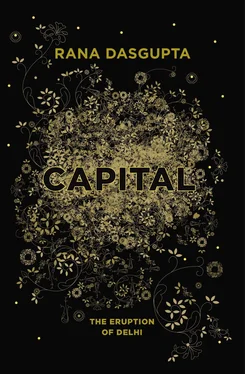“Everyone works hard. Everybody works hard — you know the guy who rides the bullock cart? — he works hard. So why is it that I’m here and he’s there? It’s all because of God. So you have to respect that. You’re the chosen one. God has been kind to you — if you don’t share that wealth, what good is it? I love my parents, I love my family. I’d do anything for them. I’d do anything for Mickey. If he came and said, ‘Get out of this house, I want to move in’ — I’d do that for him.”
Mickey is the person who introduced us, a prominent real-estate tycoon, younger and richer than Rakesh. I ask how they met.
“You know, I’d come back from Japan and in addition to car seating we were also doing auditorium seating, entertainment seating — you know, with the multitextures and all that. He was building his first shopping mall at that time, and I was supplying seats for the cinema, so I went to his office to meet his guys. And as I went down the stairs to leave, he was walking up, and he asked me who I was and for thirty seconds on the stairs there was this amazing chemistry. And I sent him an invitation to my party that year and my asshole security guys forgot to clear his name and he was turned away at the gate. He didn’t even say anything. His grace and humility were amazing, man. And the next year I invited him again. And that party was the real cement of our relationship. We got so close that night and it’s been the same ever since.”
I’m standing in the night outside. Rakesh says, “But the fact is in this bad-guy world you can be too nice to people. People take you for granted. I’m nice. I’m not ruthless, frankly I’m not ruthless. That’s probably a drawback I have. I should be ruthless.”
And he adds, by way of explanation,
“We come to this world naked, and we fucking go back naked.”
• • •
I walk through the car park, which has filled up with the sports cars of Rakesh’s friends. The moon is bright. I get in my car and set off down the drive, the security guards semaphoring. I pass the massive electricity generators that supply the compound. The guard house. Finally, the gate is opened and I pull out into the street. I drive through the desolate high-walled lanes that wind between the farmhouses, reach the roar of the main road, and head back towards the city.
In Delhi, the road is the place from which people derive their image of the entire city . It is a segregated city, a city of hierarchies and clannish allegiances, where very few people from any sector of society enjoy the idea of social distinctions being lost — and it has no truly democratic spaces. Delhi’s bizarre vocabulary of residential addresses — much of it derived from the time when the city was a British administrative township, with all the attendant social and security paranoia — says much about what people in this city expect from home: they live in housing societies and estates which are contained in blocks , themselves sub-divisions of sectors, enclaves and colonies. In wealthy neighbourhoods, gates and security guards prevent unauthorised movement across the dividing lines. Social life is no different. Delhi is not like Mumbai, whose citizens readily strike up conversations with strangers in bars and restaurants; here, introductions are necessary. People want to know who you are before they will let you in, which is why name- and address-dropping are so much part of social conversation: people must advertise their connections and allegiances if they are to enjoy a proper social existence. At the top end, social spaces cater to the desire for segregation by allocating price tags, which is why otherwise unremarkable nightclubs can find people queuing up to pay a Rs 20,000 [$400] cover charge.
Not even the snaking Delhi Metro can bring everyone together: though it provides 2.3 million rides a day, it is neglected by both the poorest and richest slices of society. So it is on heaving, honking, smoking traffic arteries such as the one I now drive on — and on which pretty much everyone is forced to move with me — that Delhi residents may have their urban revelation: the entire city, arrayed.
The first thing one notices here, perhaps, is that little allowance is made for walking. Delhi is sometimes compared to Los Angeles because of the highway-like thoroughfares that have grown up over the last fifteen years, which disregard all movement save that of the automobile; and getting around on foot can be fantastically arduous. Middle-class newcomers from other cities sometimes try to walk here, but even before concerned Delhiites can rush to inform them how unseemly this is for people of their station, they discover for themselves that Delhi’s sidewalks, where they exist, are a hoax. Setting out on one of these rickety things they have watched it come to an abrupt end; persisting nonetheless with their journey they have found themselves clambering over great piles of rubble, throwing bricks ahead of themselves on which to step through lakes of stagnant water, running madly across eight lanes of a highway — and they have quickly decided to buy themselves a car. This is why Delhi accounts for such a disproportionately large percentage of India’s booming car sales — the sales that help to stoke Rakesh’s ambitious growth plans. Cramped Mumbai, whose elongation is well served with trains, provides diminishing returns to car buyers; in Delhi, with its broad, radial avenues, nothing works as well as having your own vehicle, which is why the capital, whose cars could have been numbered with four digits in 1980, now sinks under their jammed-up weight.
For middle-class people, therefore, the spectacle of the city is seen through car windows. If a painter were to paint this middle-class view, as, for instance, so many nineteenth-century painters tried to paint Paris from the perspective of its new, cosmopolitan boulevards, it would not, accordingly, be smooth or intimate. There would be no dwelling, like the Impressionists, on details of costume and gesture, no slow rendition of café light falling on pedestrian faces, no capturing of the almost unnoticeable interactions that happen between strangers in a public place. No, it would be a strobe-lit succession of unrelated glimpses: the covers of Vogue and Autocar flashing in front of the window as a magazine seller rushes between vehicles stopped at a traffic light, the wind-rushed hair of a woman and her child on the back of a speeding motorbike, the one eye of a stray dog caught in the headlights, the glinting instruments of a wedding band — and the whirl of the dancing procession, and the improbable white of the groom’s horse — the lipstick of a cluster of eunuchs pressing their faces to the window, the slump of a human form under a blanket on the highway’s central divide, a face in another car momentarily stripe-lit as veering headlights dazzle the rear-view mirror — and a host of impressions of other, unformed characters, animal and human, whose identity it is difficult to discern.
This is my field of vision as I drive. Car lights weave in every direction, blinding high beams all, and in the retinal shadow dart unlit human bodies, almost indistinguishable from the night. Horns blare continually, for the traffic is not a stream that carries you with it, but a jungle through which you hack. People drive as if everyone is against them, and in fact it is true: any space or opportunity they do not seize with all the speed and bulk of their vehicle is immediately usurped by someone else. You can see it here, at a red light, where everyone is looking around to make sure no one else is scheming to take their advantage away. Some cars out front, of course, simply make a dash across the junction, through the contrary traffic — those who wish to assert their freedom from plebeian constraints like traffic lights. The remaining cars inch forward intently, annexing what ground they can, trying to block their neighbours from leaping ahead of them when the lights change. The pack jostles onwards and gradually bleeds out into the junction.
Читать дальше











